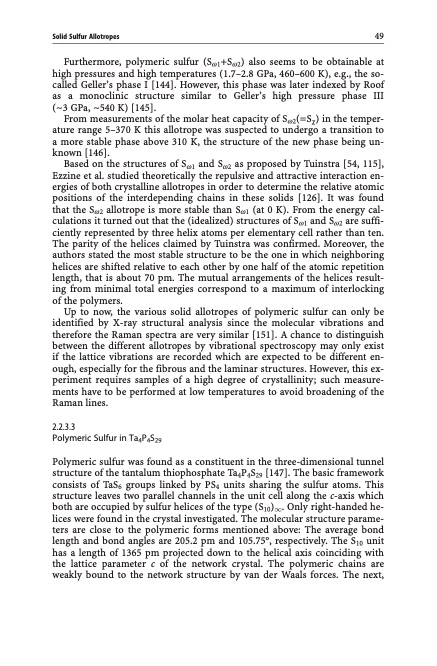
PDF Publication Title:
Text from PDF Page: 059
Solid Sulfur Allotropes 49 Furthermore, polymeric sulfur (Sw1+Sw2) also seems to be obtainable at high pressures and high temperatures (1.7–2.8 GPa, 460–600 K), e.g., the so- called Gellers phase I [144]. However, this phase was later indexed by Roof as a monoclinic structure similar to Gellers high pressure phase III (~3 GPa, ~540 K) [145]. From measurements of the molar heat capacity of Sw2(=Sc) in the temper- ature range 5–370 K this allotrope was suspected to undergo a transition to a more stable phase above 310 K, the structure of the new phase being un- known [146]. Based on the structures of Sw1 and Sw2 as proposed by Tuinstra [54, 115], Ezzine et al. studied theoretically the repulsive and attractive interaction en- ergies of both crystalline allotropes in order to determine the relative atomic positions of the interdepending chains in these solids [126]. It was found that the Sw2 allotrope is more stable than Sw1 (at 0 K). From the energy cal- culations it turned out that the (idealized) structures of Sw1 and Sw2 are suffi- ciently represented by three helix atoms per elementary cell rather than ten. The parity of the helices claimed by Tuinstra was confirmed. Moreover, the authors stated the most stable structure to be the one in which neighboring helices are shifted relative to each other by one half of the atomic repetition length, that is about 70 pm. The mutual arrangements of the helices result- ing from minimal total energies correspond to a maximum of interlocking of the polymers. Up to now, the various solid allotropes of polymeric sulfur can only be identified by X-ray structural analysis since the molecular vibrations and therefore the Raman spectra are very similar [151]. A chance to distinguish between the different allotropes by vibrational spectroscopy may only exist if the lattice vibrations are recorded which are expected to be different en- ough, especially for the fibrous and the laminar structures. However, this ex- periment requires samples of a high degree of crystallinity; such measure- ments have to be performed at low temperatures to avoid broadening of the Raman lines. 2.2.3.3 Polymeric Sulfur in Ta4P4S29 Polymeric sulfur was found as a constituent in the three-dimensional tunnel structure of the tantalum thiophosphate Ta4P4S29 [147]. The basic framework consists of TaS6 groups linked by PS4 units sharing the sulfur atoms. This structure leaves two parallel channels in the unit cell along the c-axis which both are occupied by sulfur helices of the type (S10)1. Only right-handed he- lices were found in the crystal investigated. The molecular structure parame- ters are close to the polymeric forms mentioned above: The average bond length and bond angles are 205.2 pm and 105.75, respectively. The S10 unit has a length of 1365 pm projected down to the helical axis coinciding with the lattice parameter c of the network crystal. The polymeric chains are weakly bound to the network structure by van der Waals forces. The next,PDF Image | Topics in Current Chemistry

PDF Search Title:
Topics in Current ChemistryOriginal File Name Searched:
Elemental-Sulfur-und-Sulfur-Rich-Compounds-I.pdfDIY PDF Search: Google It | Yahoo | Bing
Sulfur Deposition on Carbon Nanofibers using Supercritical CO2 Sulfur Deposition on Carbon Nanofibers using Supercritical CO2. Gamma sulfur also known as mother of pearl sulfur and nacreous sulfur... More Info
CO2 Organic Rankine Cycle Experimenter Platform The supercritical CO2 phase change system is both a heat pump and organic rankine cycle which can be used for those purposes and as a supercritical extractor for advanced subcritical and supercritical extraction technology. Uses include producing nanoparticles, precious metal CO2 extraction, lithium battery recycling, and other applications... More Info
| CONTACT TEL: 608-238-6001 Email: greg@infinityturbine.com | RSS | AMP |